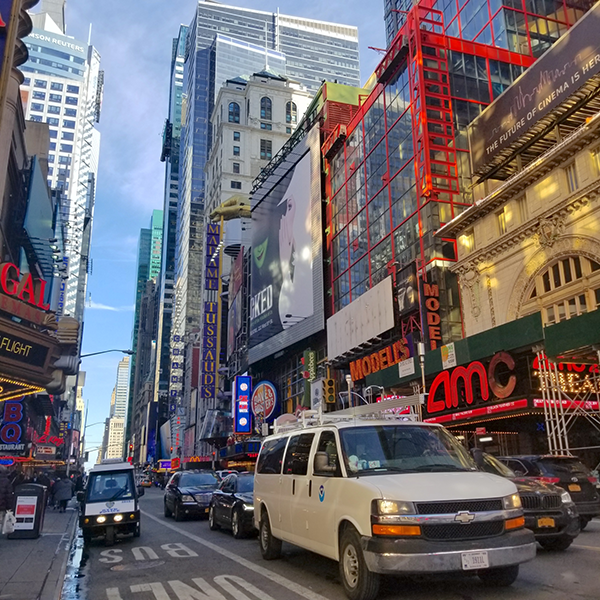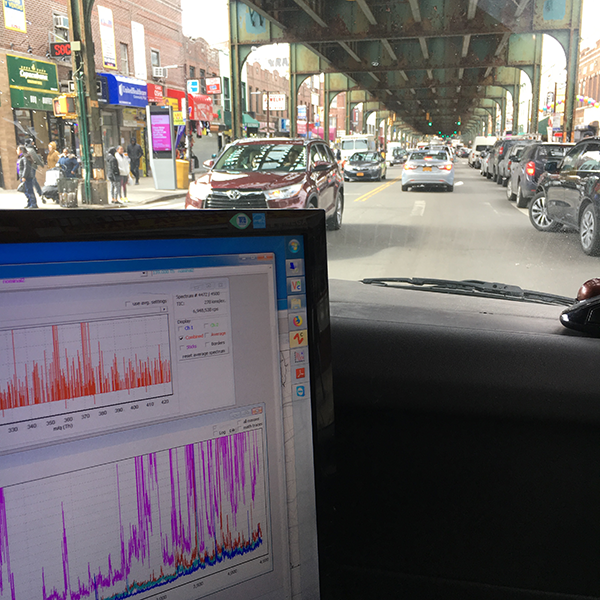A .gov website belongs to an official government organization in the United States.
A lock () or https:// means you've safely connected to the .gov website. Share sensitive information only on official, secure websites.
3 August 2021

NOAA scientists now turn their attention to Las Vegas and Los Angeles.
It's hot. Time for deodorant, sun block, and bug spray; some conditioner to keep your hair from turning to straw, and maybe a little air freshener for the laundry room where a damp pile of workout clothes awaits.
New research from NOAA finds that personal care products like these are now responsible for a significant amount of the ozone pollution known as smog that plagues major urban areas. In New York City, for example, air samples collected during a 2018 field mission by an instrumented NOAA mobile laboratory showed that fragrant personal care products generated about half of the volatile organic compounds, or VOCs, that were generated by people but not produced by vehicle exhaust. VOCs are a primary ingredient in the formation of ground-level ozone, which can trigger a variety of health problems in children, the elderly, and people of all ages who have lung diseases such as asthma. The findings were published this week in the Proceedings of the National Academy of Sciences.
"The big takeaway is how much VOC emissions from consumer products increase as urban population density increases, and how much these chemicals actually matter for producing ozone," said researcher Matthew Coggon, a CIRES researcher working at NOAA CSL who was lead author of the new study.
Now researchers in the NOAA Chemical Sciences Laboratory have turned their attention to two of the largest metropolitan areas in the Southwest U.S. This August will be the second consecutive month they will be conducting mobile laboratory and ground-site measurements in collaboration with university colleagues and stakeholders as part of the Southwest Urban NOx and VOC Experiment (SUNVEx), which will investigate VOCs and other sources of urban air pollution in Las Vegas and Los Angeles.
For decades, air quality regulators made progress in reducing urban smog by controlling VOCs generated by the transportation and electric power sectors. Despite those gains, groundbreaking research published by NOAA scientists in 2018 showed that fossil fuel-based chemicals in a wide range of consumer products had emerged as a rival to tailpipes as a source of VOCs.
Coggon's study built on another study published earlier this year in Environmental Science & Technology, which found volatile consumer products including paints, cleaners, and personal care products were responsible for 78% of the Manhattan VOC budget, versus just 22% for transportation.
The lead author of that study, CIRES scientist Georgios Gkatzelis, said he was initially skeptical that consumer products could play such a big role in ozone pollution. "Seeing all those cars when biking to work in Boulder, Colorado convinced me they had to be the dominant VOC source," said Gkatzelis, now a research scientist in Germany. "But after driving our NOAA van though New York City and watching our instrument displays, Matt and I were often shouting at each other in amazement at what we were seeing."
Measurements taken in much less densely developed Boulder, Colorado, showed these volatile consumer products were still responsible for 42% of human-caused VOCs in the local atmosphere, with the transportation sector responsible for the rest. Gkatzelis estimated that averaged nationwide, 50-80% of pollution-forming urban VOCs are associated with volatile consumer products.
VOCs are a class of carbon-based compounds that arise from many different sources, both natural, like pine forests, and man-made, like fossil fuel emissions. The relative contributions from natural or man-made sources can vary widely between rural and urban areas.
Volatile consumer products are a category of VOCs that share two common characteristics. In order to function as designed, key ingredients must evaporate, to carry scent for example, or to cause a residue to stick to a surface. These evaporative ingredients are typically derived from fossil fuels.
VOCs are one of two critical constituents needed to produce ground-level ozone pollution and urban smog - nitrogen oxides ( or NOx ) being the other. In the air, sunlight can trigger VOCs to react with NOx to form ozone and particulate matter. Air quality regulations typically target both to control ozone pollution.

In 2018, Coggon, colleague Georgios Gkatzelis, and other CSL scientists drove a mobile laboratory carrying sophisticated instrumentation, capable of identifying and measuring hundreds of different VOCs in the air, from Boulder, Colorado to New York City for three weeks of sampling in March, and repeated the trip in July. At the same time, a ground site at the City College of New York continuously monitored VOCs and other air pollutants in downtown NYC. The following summer, colleagues in Europe replicated the sampling strategy, driving a comparably outfitted mobile lab from Switzerland to Slovakia.
Taken together, the analyses show that VCPs are ubiquitous in urban centers, contributing up to half or more of the total anthropogenic VOC emissions in the U.S. and European cities that were investigated. Vehicle traffic dominates the remainder.
One specific category of VCPs known as monoterpenes are aromatic chemicals used as fragrances that mimic the naturally occurring compounds found in trees and botanicals. These compounds are what give pine trees and citrus their characteristic odor. The naturally occurring, or biogenic, monoterpenes are known to be a major source of ozone production in heavily vegetated cities, such as Atlanta in the southeast U.S., and the synthetic versions of these compounds are just as efficient in forming ozone.
Because monoterpenes are emitted by vegetation in the spring and summer, the winter measurements were critical for determining how much the synthetic fragrances were contributing to the total monoterpenes in and around the city.
That produced another surprising finding: "The emission rate of synthetic monoterpenes from Manhattan itself is comparable to the natural emissions we'd expect from a dense forest of equivalent size in the southeast U.S.," Coggon said.

Using an air quality model, the researchers simulated the chemistry of ozone formation in New York City, focusing on a heat wave period throughout July 2018 when NYC experienced numerous events of high ozone in excess of 110 parts per billion (ppb), exceeding the EPA's National Ambient Air Quality Standards (NAAQS) of 70 ppb.
"The model results showed that about half of the ozone produced locally around NYC was due to anthropogenic VOCs (VCPs + vehicles), and the other half due to biogenic sources. Fifty percent of that anthropogenic portion, or about 10 ppb of ozone, was directly due to the VCPs," said Coggon.
These two studies, plus earlier work, strongly suggest air quality models must be updated to account for both the emissions and atmospheric chemistry of these volatile consumer products to capture their full impact on urban air quality, Coggon said. And in areas where ozone pollution is a problem, new strategies to control VOC sources may need to be devised.
"We know now that these products are making ozone pollution worse," Coggon said. "We can't control what the trees are emitting, but what we can do is look for ways to make these common everyday products less polluting."
Coggon, M.M., G.I. Gkatzelis, B.C. McDonald, J.B. Gilman, R.H. Schwantes, N. Abuhassan, K.C. Aikin, M.F. Arend, T.A. Berkoff, Steven.S.Brown, T.L. Campos, G. Gronoff, J.F. Hurley, G. Isaacman-VanWertz, A.R. Koss, M. Li, S.A. McKeen, F. Moshary, J. Peischl, V. Pospisilova, X. Ren, A. Wilson, Y. Wu, M. Trainer, and C. Warneke, Volatile chemical product emissions enhance ozone and modulate urban chemistry, Proceedings of the National Academy of Sciences, doi:10.1073/pnas.2026653118, 2021.
Decades of air quality improvements have substantially reduced the motor vehicle emissions of volatile organic compounds (VOCs). Today, volatile chemical products (VCPs) are responsible for half of the petrochemical VOCs emitted in major urban areas. We show that VCP emissions are ubiquitous in US and European cities and scale with population density. We report significant VCP emissions for New York City (NYC), including a monoterpene flux of 14.7 to 24.4 kg · d−1 · km−2 from fragranced VCPs and other anthropogenic sources, which is comparable to that of a summertime forest. Photochemical modeling of an extreme heat event, with ozone well in excess of US standards, illustrates the significant impact of VCPs on air quality. In the most populated regions of NYC, ozone was sensitive to anthropogenic VOCs (AVOCs), even in the presence of biogenic sources. Within this VOC-sensitive regime, AVOCs contributed upwards of ∼20 ppb to maximum 8-h average ozone. VCPs accounted for more than 50% of this total AVOC contribution. Emissions from fragranced VCPs, including personal care and cleaning products, account for at least 50% of the ozone attributed to VCPs. We show that model simulations of ozone depend foremost on the magnitude of VCP emissions and that the addition of oxygenated VCP chemistry impacts simulations of key atmospheric oxidation products. NYC is a case study for developed megacities, and the impacts of VCPs on local ozone are likely similar for other major urban regions across North America or Europe.
Gkatzelis, G., M. Coggon, B. McDonald, J. Peischl, J. Gilman, K. Aikin, M. Robinson, F. Canonaco, A. Prevot, M. Trainer, and C. Warneke, Observations confirm that volatile chemical products are a major source of petrochemical emissions in U.S. cities, Environmental Science & Technology, doi:10.1021/acs.est.0c05471, 2021.

Despite decades of declining air pollution, urban U.S. areas are still affected by summertime ozone and wintertime particulate matter exceedance events. Volatile organic compounds (VOCs) are known precursors of secondary organic aerosol (SOA) and photochemically produced ozone. Urban VOC emission sources, including on-road transportation emissions, have decreased significantly over the past few decades through successful regulatory measures. These drastic reductions in VOC emissions have led to a change in the distribution of urban emissions and noncombustion sources of VOCs such as those from volatile chemical products (VCPs), which now account for a higher fraction of the urban VOC burden. Given this shift in emission sources, it is essential to quantify the relative contribution of VCP and mobile source emissions to urban pollution. Herein, ground site and mobile laboratory measurements of VOCs were performed. Two ground site locations with different population densities, Boulder, CO, and New York City (NYC), NY, were chosen in order to evaluate the influence of VCPs in cities with varying mixtures of VCPs and mobile source emissions. Positive matrix factorization was used to attribute hundreds of compounds to mobile- and VCP-dominated sources. VCP-dominated emissions contributed to 42 and 78% of anthropogenic VOC emissions for Boulder and NYC, respectively, while mobile source emissions contributed 58 and 22%. Apportioned VOC emissions were compared to those estimated from the Fuel-based Inventory of Vehicle Emissions and VCPs and agreed to within 25% for the bulk comparison and within 30% for more than half of individual compounds. The evaluated inventory was extended to other U.S. cities and it suggests that 50 to 80% of emissions, reactivity, and the SOA-forming potential of urban anthropogenic VOCs are associated with VCP-dominated sources, demonstrating their important role in urban U.S. air quality.